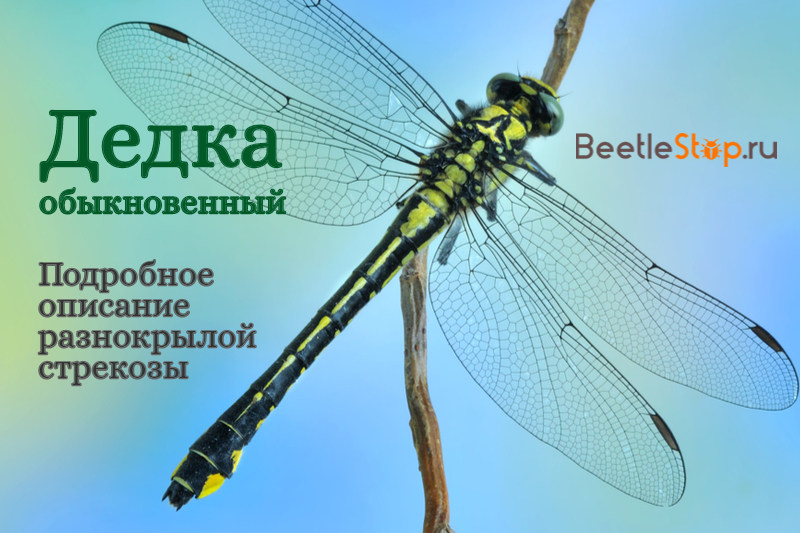Grandfather ordinary - typical river dragonfly
Due to the specific appearance of dragonflies, you can not confuse with other insects - a long thin abdomen, convex spherical eyes, two pairs of transparent wings on the back. You can meet them not far from standing reservoirs or rivers with a quiet course. Aerial predators fly in the daytime, hunting for flies and mosquitoes. A third of all known dragonfly species belong to the grandfather family. Its representatives are medium in size and have wide-set eyes. Common Grandfather - a typical species, common in Europe and Asia. Its larvae live in flowing waters, burrowing into a muddy or sandy bottom.

Morphological description
The common grandfather (Gomphus vulgatissimus) is a species from the family of the grandfather, suborder of diverse dragonflies. Body length 45-50 mm, wingspan up to 70 mm. Females and young males are colored the same, they have a yellow chest with slanting black stripes, completely black on the underside. The main color of the abdomen is black, yellow spots on the sides, an intermittent longitudinal line on top of the same hue.
The faceted eyes in females are yellow-green, in males blue. The organs of vision of dragonflies have an interesting structure, they consist of thousands of small eyes. Each provides the vision of a particular area, the result is a picture with a broad perspective. Between the large convex eyes, three simple eyes and short antennae are located.
Interesting fact. With age, the color of the males changes, the yellow areas become bluish-green.
At the base of the rear pair of male wings there is a rounded neckline. Both pairs of wings are transparent, without a pattern. The abdomen consists of 10 main and 1 rudimentary segments. The end of the abdomen is club-shaped, swollen, these segments are completely painted black. All three pairs of limbs are black, sometimes there are yellow stripes on the hips and lower legs of the front legs.
Habitat
The species of grandfather is common in Europe. Insects are found in the northern part (Great Britain, Sweden, Norway, Finland), in the center (France, Germany) and in the south (Spain, Romania). Dragonflies live in Central Asia and the Caucasus. In Russia, they are found in territories from European regions to southwestern Siberia. Insects fly near mountain rivers at an altitude of up to 2000 m.
Information. In 2010, the species of grandfather was added to the IUCN Red List. Since that time, the number of insects has stabilized and is gradually increasing.
Lifestyle & Reproduction
The life span of adult dragonflies Gomphus vulgatissimus is limited to four weeks. Years of imago begin in May, lasts until July. During this time, they manage to find a partner, lay eggs and exterminate a lot of harmful insects. In spring, dragonflies can be found on forest edges, clearings with dense vegetation. During the day, they tirelessly hunt, eating small prey right in the air. In case of catching a large insect, they sit on the plant for a quick lunch.
Summer is the time of breeding, grandfathers fly near the shores of wide slow rivers, streams, canals, forest lakes in search of a mating partner. For attachment to flowing ponds, dragonflies are called riverboats. Adult males show territorial instincts, divide coastal areas and patrol.After fertilization, females without an ovipositor circling above the water, lowering the abdomen into it. So they drop eggs.
Offspring development
For the life of grandfather’s larvae, ponds with a muddy or sandy bottom are necessary. Offspring love to bury themselves in bottom sediments. Activity is shown at night. The body is oblong, the abdomen is flat and wide. Legs are strong, digging. The rudiments of the wings are parallel. Predatory nymphs obtain food with the help of a grasping device in place of the lower lip - the mask. In the offspring of grandfather it is flat. The body of the larvae is covered with hairs.
The gills located in the intestinal walls allow them to breathe under water. By shortening and relaxing the abdomen, nymphs fill the abdomen with water through the anus. For some time they can breathe atmospheric air. Grandfather's larvae are sensitive to water quality, pollution affects them destructively. Negatively affect their number of work to deepen the bottom. Together with the removed sludge, dragonfly nymphs enter the bucket. It is recommended to leave the sludge for several hours near the reservoir, this gives the larvae the opportunity to return to the water.
In the process of nymph development, 10 ages pass. By the age of fledging, they go 2-4 years. To turn into a dragonfly, the larva is selected on an aquatic plant. After leaving, it dries up, the skin on its back bursts. A slender dragonfly appears from a nondescript nymph. It takes her several hours to spread her wings.

